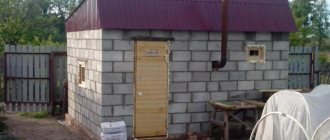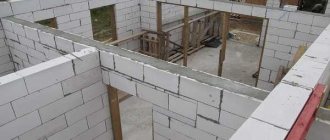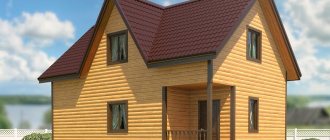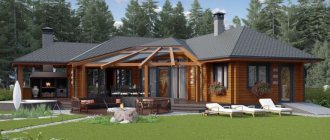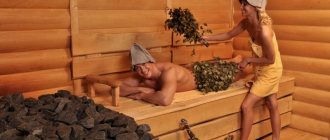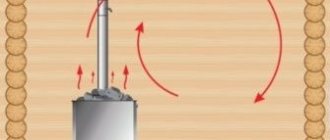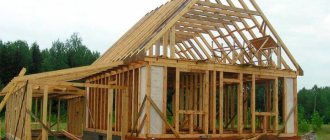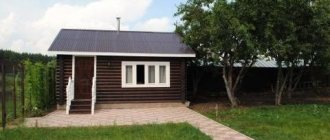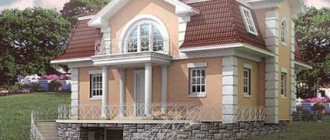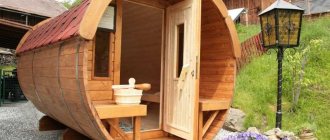Arrangement of a bathhouse as a separate building is an opportunity to supplement it with premises to increase the comfort of relaxation.
A good option is a bathhouse with a terrace. In its classic form it will look like a small house with a canopy fenced with railings. Inside there is a table, chairs or wicker chairs.
But with the desire and financial capabilities of the owners, it will be possible to create an entire bathhouse complex with a veranda of interesting design.
Users often search for:
- Bath interior finishing options
- What stones to choose for a bath
Photos of bathhouse projects with a terrace
Even at the planning stage, it is important to correctly determine the location of the future structure so that the developed technical documentation complies with the norms of current legislation.
When designing, it is necessary to take as a basis SNiP 30-02-97 and SP 11-106-97, which clearly define the rules for the development of suburban areas and indicate the recommended distance of the structure being created from other objects.
According to the standards, the minimum permissible distance of a bathhouse from other buildings, vegetation to:
- main residential building - from 7 to 10 m;
- roadway - from 6 to 7 m;
- borders of the estate, fence - from 1 to 3 m;
- neighbors’ houses – from 15 to 17 m;
- wooden utility blocks - from 10 to 13 m;
- structures made of non-combustible materials - from 6 to 9 m;
- well – 10 m;
- forests – 16 m;
- trees – 4 m;
- bushes - 2 m.
If the terrain allows, then the craftsmen recommend building a bathhouse on a hill to simplify the drainage of water from the steam room, shower and improve ventilation. In this case, screw piles will be the best foundation.
Let's take a closer look at the features and advantages of different designs with a terrace with examples of finished objects in the photo.
Individual projects
When developing individual projects, architects will be able to take into account all the customer’s preferences, the features of the layout of the dacha area and the size of the buildings. Using modern finishing materials, specialists create original solutions for the entertainment area in the country. So, you can install French glass, and thereby partially turn it into a veranda.
Multi-level structures are used when the site is created from several floors. This option is good for a small area. For a classic Russian-style steam room, they offer a standard design that includes guest apartments, a place to relax, prepare barbecue, and a locker room where clothes are left before washing. Such a space can be used for household needs when the bathhouse is not heated. You can make the object two-story. In this case, the guest rooms are located on the top floor.
Under the same roof
It is considered a universal option. Most often, summer residents build this way due to the ease of construction and economical consumption of materials.
Photo: bathhouse made of foam blocks and a summer terrace with barbecue under one roof
When the terrace is under a common roof with a bathhouse, the rafter system rests on beams - frame elements. The option of fastening fencing is possible.
The photo below is an example of a beautiful bathhouse made of fresh logs, complemented by a summer extension for relaxation.
Here is a version of a timber bathhouse with a small terrace. Floor finishing - decking. The roof is pitched. The design looks simple and at the same time modern.
The terrace can be located along the facade (front), next to one of the walls (side), along three walls or around the entire building (encircling), along adjacent walls (corner).
With grill or barbecue
The recommended area of the attached room, taking into account the installation of a barbecue, is from 7 square meters. m or more. For a large company, an area of 10 square meters is considered optimal. m. If in the first case it will be possible to place only a table with chairs, then in the second it will be possible to add several wicker chairs. Vacationers will not be disturbed by smoke from the barbecue. The person doing the cooking will not be constrained in his movements.
It is important to take into account that the foundation for the barbecue installation is laid separately. The average height is 70 cm from the floor.
The main material for the construction of the furnace is red fireclay brick, which has increased resistance to high temperatures.
To eliminate the risk of fire from a barbecue, the area around is laid with fireproof ceramic paving slabs.
The stove itself is lined with artificial or natural stone.
It is necessary to choose the right location and install a chimney, which is responsible for removing burning and smoke from the room. The comfort of not only vacationers, but also neighbors depends on the quality of work.
You can also provide space for a niche that will serve as a woodshed.
With a well-designed plan, such a terrace will take on the functions of a summer kitchen.
Glazed
Glazing of the veranda is made of plastic, aluminum, and wooden sliding frames.
Plastic frames are an essential element of warm glazing. Used in closed extensions for year-round use. Provide good heat and noise insulation.
Aluminum and wooden frames with glass are placed in unheated extensions, since they do not retain heat well and the indoor temperature in cold weather differs from the outdoor temperature by only a couple of degrees.
Photo: log house with terrace and bathhouse
The veranda with panoramic glazing looks great. Vacationers have an overview of the site. Being indoors, a person becomes closer to nature.
The downside is that everything that happens in the extension is also clearly visible.
Another option for glass structures is sliding walls. The closed veranda quickly transforms into an open one. The frame is made of plastic.
The windows can be decorated with multi-colored stained glass windows, thanks to which the lighting in the room will shimmer in different colors.
Two-story
A two-story structure is suitable for owners of a small plot, with no space for the construction of additional extensions.
In the classic version, the steam room, shower room, dressing room are located on the first floor, the guest or relaxation room is on the second.
Photo of a wooden bathhouse made of rounded logs with a small terrace and balcony.
The second floor turns out to be an attic and is located under a sloping (gable) roof. Due to this form, the free space can be fully utilized.
We must not forget the regularity - the larger the area of the structure, the longer it will take to warm up.
The main requirement for buildings with several floors is the presence of reinforced floors that will support not only the weight of a person, but also furniture.
The two-story bathhouse with a covered terrace can comfortably accommodate many guests. If space allows, then one rest room should be made downstairs, the second upstairs.
One-story
Photo: Russian-style bathhouse
Usually this is a small house with a covered summer extension for relaxation. The internal set of rooms is standard - locker room, washing room, steam room. Construction of a one-story bathhouse is inexpensive.
But there are also one-story bathhouses of increased comfort, which have a swimming pool, a relaxation room, several bathrooms, and a kitchen. Such a project costs many times more.
The terrace for such a building is a remote seating area for warm weather. If we are talking about a glassed room, then you can use it all year round.
Closed
Can be used regardless of the season or outside temperature. It is customary to glass it with metal-plastic double-glazed windows, which perfectly retain heat in the room. The roof can also be made transparent if desired.
A stove and a fireplace for heating are installed inside, and a niche is set up for a woodshed. An alternative is gas or electric heating.
Flowers in pots are placed on the walls and window sills. Skillful housewives turn such a terrace into a full-fledged greenhouse.
The construction requires high-quality insulation of both the foundation, walls, and roof.
If the area is large, then you can make a gym or home library on the terrace.
Open
It is considered a summer recreation area. It is not customary to glaze it. Instead of walls and windows, railings up to 1 m high are installed around the perimeter. Depending on the project, you can do without them altogether.
This covered canopy is good protection from rain and sun.
The floor is made slightly sloping for better water drainage. Material – terrace board, stone, tile.
Photo: you can make a garden house or a small bathhouse from a construction trailer
The following are placed in the open area:
- table with chairs;
- shops;
- sun loungers;
- wicker rocking chairs;
- barbecue and woodshed for it;
- small cutting table.
The number and types of interior items are selected according to the area of the structure.
With a balcony
A balcony can be added to two-story baths. But such construction will take a lot of time and money. The average area of such a structure with a balcony is from 30 to 45 sq.m. In bath complexes the figure is significantly higher.
At the project development stage, several sketches of the future balcony are created separately, a view from the outside and inside, the material consumption is calculated, and a decision is made whether to cover it with double-glazed windows or leave it open.
The roof for such a bathhouse is made so that it completely covers the balcony.
Roofing at an angle - reducing free space. But nevertheless, there will be enough space on the second floor to install a billiard table, a large corner sofa with armchairs and a table.
The space leading up will also be taken up. The design of the steep spiral staircase is interesting. Classic - carved wood.
With a rest room
With it, the bathhouse turns into a guest house. In the recreation room, a wood-burning or electric fireplace is installed, a plasma TV is hung on the wall, and chairs and a sofa are placed. Avid athletes equip the room with exercise equipment.
Photo of a wooden bathhouse project with a relaxation room on the second floor.
Let's assume the option of an open veranda. When, after a steam room in warm weather, guests are placed in the fresh air.
Bath complexes have several rest rooms.
If you don’t have the money to build such a structure, you can easily rent it for a few days.
After all, constant maintenance and heating of such a building is expensive. It is not surprising that many owners take up construction not for personal recreation, but to make a profit from rentals.
Pros of having a relaxation room in the bathhouse:
- year-round operation;
- your rest will not be disturbed by annoying insects;
- possibility of installing various household appliances;
- reception and accommodation of guests.
There are projects where the room is equipped with a minibar, a billiard table, armchairs and a poker table.
We recommend reading our other articles:
- Do-it-yourself bathhouse shelf made of wood
- How to make a bath floor correctly
Layout and location
Before you start building a gazebo, you should find a suitable location for it. Usually it is done along the entire facade of the building. This arrangement allows you to save on materials and makes movement more comfortable for those leaving the steam room. In this type of design, there is no need to talk about a shortage of space for cooking and dining. With this placement, the veranda or terrace can be partially open or partially closed. Using external walls allows you to save on building materials. The choice of a suitable layout will ensure the construction of an object of architectural appearance that is in the general style of the entire complex of buildings.
The option of erecting a structure along one of the walls is also used. This type of layout is suitable for cases where there is a shortage of space. When creating optimal zoning, you need to provide places for eating and preparing food, and for entertainment. To do this, you must correctly determine the dimensions of the object being built at the dacha.
You can use a corner construction option. In this case, the stove will be installed on the most covered area. The corner model is used when there is a shortage of adjacent territory in the country.
In some cases, a covered barbecue area is built separately, close to the bathhouse complex. Then there is a small transition between the steam room and the resting place. This option is suitable for summer use.
Pile foundation
Drawings and diagrams of a bathhouse with a terrace
Photo: diagram of a two-story wooden bathhouse 6x6 meters.
Following the step-by-step instructions, the first step is to draw up a drawing of the future structure. As a basis, you can take existing buildings with completed calculations, a ready-made estimate, or develop a project yourself.
A visual image of the building simplifies and speeds up installation work, and allows you to document and eliminate possible shortcomings.
For a small family of 2-3 people, a one-story bathhouse with a closed terrace is quite enough. If the number of residents reaches 5–8 people, then it is better to consider the design of a medium-sized bathhouse with an attic.
Downstairs, according to the standard, there is a steam room, a shower room, a dressing room, a relaxation room and a kitchen (if the area allows). The second floor is equipped for comfortable leisure of the whole family. A billiard table is installed here, a games room or home cinema is set up.
The diagram above is an example of a one-story bathhouse with a terrace and a swimming pool inside.
Photo. Bathhouse 2.3x6 meters made of profiled timber 100x150x6000 mm with an open terrace 2.3x1 m under a common roof.
This drawing is suitable for a country holiday with a small family. An open extension is made under one roof.
Scheme of a one-story bathhouse 6x6 meters
This is an example of a one-story bathhouse with an open terrace and a large relaxation room.
Bathhouse layout with a garage for 2 cars, a veranda and a utility room.
An interesting design option, where the bathhouse is combined with a garage on one side, and on the other side there is a terrace, and there is also a utility room.
Terrace and veranda: differences
Veranda and terrace are eternal synonyms. In fact, although these concepts are quite similar, there are a number of generally accepted differences that make it possible to designate certain structures as terraces and others as verandas.
A terrace is an extension that has its own foundation and is raised above the ground. It must have a fence, but in general it is open. It is also not insulated.
The veranda, in turn, is built into the main building, its foundation is one with the foundation of the main building. Very often the veranda is glazed and is often insulated.
Of course, many people want to write the word terrace as terrace. And in any case, they pronounce it exactly as terrace. Remembering the correct spelling is not difficult if you realize that it comes from the word " terra ", meaning earth.
Selection of materials for building a bathhouse
Let's look at the types of raw materials that are in greatest demand.
Tree
Traditional material for Russian baths. Retains heat well and is environmentally friendly. Certain breeds have a healing effect on the body.
But wood requires additional protection from moisture, insects, and fire, so before construction it is treated with special means.
For a small bathhouse with a terrace, a columnar foundation or, on difficult soils, a pile foundation is sufficient.
In order for the tree to last longer, it is necessary to make high-quality waterproofing between the wooden covering and the foundation.
The following types of wood are used for construction.
Log
Whole, sanded trunks are taken, which do not need to be rounded. The construction of a bathhouse from a fresh log house is done by grooving the parts together.
The logs are placed perpendicular to each other. Gutters are formed in them, along the edges there are recesses of the same size.
If you order calibrated logs of the same diameter, the corners of the building will look neater.
The wood is impregnated with antiseptics and fire retardants (the latter are needed for protection against fire).
Beam (profiled, glued)
Logs are cheaper, which is why they are more popular.
There is a particularly high demand for profiled timber, which is usually profiled on a special machine, giving an ideal smoothness to the surface. The top of the raw material is coated with antiseptics and varnish, due to which the wood does not darken.
The outer part of the structure does not require additional finishing.
For construction, timber is cut to specified sizes. Wooden pins are used to connect the elements.
There is no need to finish the interior. But if ordinary timber was taken, then the owners prefer to cover the walls with clapboard, choosing hardwood raw materials. Coniferous species are used in rooms where there are no high temperatures (not suitable for steam rooms).
The finished design turns out neat and modern, becoming an environmentally friendly decoration of the estate.
Frame technology
This is a prefabricated bathhouse with a small canopy. It won't cost much. It will fit even on a site with limited space. Differs in installation speed. A popular material is timber.
If the structure is well insulated, it can be used in winter.
Block and brick
They are used for the construction of baths that will be used at any time of the year. Due to the significant weight of the raw materials, it is necessary to take care of pouring a reliable foundation.
Let's take a closer look at the features of the materials.
Foam block
Foam concrete has a porous structure. It is considered a breathable material. Light in weight. Large block sizes speed up laying.
Due to its poor resistance to moisture, a building made of foam concrete requires mandatory cladding both outside (along the facade) and inside.
Exterior finishing options:
- clinker tiles;
- decorative plaster;
- siding;
- block house.
The quality of thermal insulation of the foam block is inferior to wood, so it will be necessary to insulate the bathhouse from the inside.
Gas silicate block
Technical characteristics are similar to foam concrete.
But gas blocks are less resistant to moisture.
To ensure that the structure lasts longer and the material does not begin to crumble, deep penetration waterproofing is used for the walls and ceiling.
The inside of the room is plastered and finished with tiles, stone or wood.
Brickwork
This material is considered a leader in fire safety.
Due to the high cost, it is rarely used for the construction of baths.
In addition, brick construction:
- takes a long time to warm up;
- needs ventilation installation;
- laying high-quality waterproofing (brick is hygroscopic).
But, once heated, the material retains heat well. Brick walls have good sound insulation and last a long time.
The inside of the bathhouse is lined with plaster and wood. It is convenient to place a small kitchen here, install a wood stove or fireplace.
The pool can be replaced with a cold water plunge pool.
What kind of foundation will be under the terrace?
For terraces with wooden flooring, a columnar foundation is often made - it is easier to manufacture and cheaper. For areas finished with tiles or porcelain stoneware, an insulated slab is needed; if the finishing is paving slabs, they can be laid on a profiled membrane and a backfill of crushed stone and sand. This is perhaps the most inexpensive and fastest option.
A pile foundation for a wooden terrace is not very expensive and labor-intensive
A pile foundation requires less expense, but only requires the installation of wooden support posts on which the roof will rest. Such barbecue terraces often have a low wooden fence. These projects “fit” well into the traditional style: they are attached to walls made of logs or timber.
Bathhouses designed in a modern style often have open terraces with tiles (ceramic or paving) lined with finishing stone. But for brick or stone pillars, it is necessary to make a shallow slab foundation with insulation. In winter, on heaving soils without insulation, not a single finishing material will hold up, and the slab may crack (and, most likely, it will). Without insulation, you can make a foundation for a terrace only on dry sandy loam soils that are not prone to heaving.
What would such a terrace look like?
Selection of materials for decking flooring
Basic recommendations for flooring in an open extension:
- Wear resistance. The material should not wear off even over the years.
- Not slippery, even when wet. This will reduce the risk of injury when walking on it.
- Low temperature resistance. Refers to regions with severe frosty winters.
- Do not deform under the influence of moisture or precipitation.
There are no such restrictions for a closed terrace, since the floor is not exposed to external factors.
Let's look at popular flooring materials.
Tiles, porcelain stoneware
The tiles are taken with the most rough, textured surface to prevent slipping.
Suitable tiles:
- ceramic;
- sidewalk;
- concrete.
It is strictly not recommended to use tiles. When wet, it becomes very slippery, which leads to unwanted injuries.
It is possible to lay porcelain tiles and pieces of stone. This flooring will go well with a bathhouse made of blocks and bricks.
Terrace board
Terrace boards are made from natural solid wood or with the addition of polymer raw materials. The latter type is preferable in an open terrace, since it is not afraid of moisture and does not deform due to temperature changes.
Available in the following breeds:
- oak;
- pine;
- ash;
- larch;
- hornbeam;
- teak.
It is used to cover the floor in bathhouses made of logs and beams, complementing the wooden ensemble.
Pile foundation for the terrace
If you plan to make a terrace with wooden flooring, you can get by with an easy-to-make pile, drilled-rammed foundation. One note: this foundation will perform well in areas with low groundwater levels. If groundwater is close to the surface, it is better to make a shallow columnar one.
It is most convenient to use pipes. Metal ones are expensive, and they also need to be carefully treated to prevent rust; asbestos-cement ones are the most acceptable option. Some people install plastic sewer lines. Despite the low strength of such formwork, it can be a good option. After all, the plastic is smooth, and it will be difficult for the emerging lateral forces of heaving to “catch” it. And they are the most difficult to deal with: they are almost not calculated.
In any case, the diameter of the pipes is about 20 cm. The pitch of installing the piles depends on the type of soil and the load on the terrace. On average it is 1-1.5 meters.
This is what a pile foundation for a terrace and its piping looks like schematically
Wells are drilled in the ground below the freezing depth of the soil. Approximately 15-20 cm of crushed stone is added and the crushed stone is compacted. Insert the pipes, placing their upper edges at the same level. To make installation easier, you can throw a couple of shovels of crushed stone inside the pipe.
Vertical installation is checked with a plumb line; alignment along planes is easier to do using stretched threads. To do this, reinforcement bars are driven in at key points, they are also positioned vertically, then cords are tied to mark the lines for installing the pillars.
Schemes for reinforcing pillars under the foundation
Two or three reinforcement bars (diameter 8-10 mm) need to be driven into each pipe. They must first be connected to each other. You can use any sufficiently flexible and strong wire that will allow you to hold the rods in a given position. The reinforcement must be positioned so that each rod is at least 5 cm from the wall. This way they will be inaccessible to moisture and oxygen, which is why they will not rust.
After installing the reinforcement, you can fill the piles with concrete mortar. To give the structure increased density, it is necessary to achieve homogeneity of the solution. In this case, you need to use a submersible vibrator for concrete, with a flexible shaft and mace length of 1.5-2 meters. As a last resort, you can pierce the concrete. They take a thick rod of reinforcement, pierce the concrete right through, and then shake it a little. This removes air bubbles. Do this immediately after pouring. As a result, the solution settles a little, you have to add a little. Another option is to knock on the pipe, but preferably either with a rubber mallet or a wooden mallet (so as not to break the asbestos, since it is quite fragile).
How to attach the harness
After the concrete has set, wooden blocks of the lower frame are attached to the posts. It is better to take timber 150*50 mm or 75*150 mm. Before laying, they are treated with impregnations and antiseptics, if desired, tinted with stains and always covered with varnish or paint. Paint and varnish products are used for outdoor work. It will reliably protect the wood from atmospheric influences.
Joist mounting options
To prevent moisture from penetrating through the concrete to the wood, a layer of waterproofing (regular or euroroofing felt in two layers) can be laid on the tops of the piles under the bars. There are no problems with attaching the joists to the concrete. You can do this in several ways:
- when pouring piles into concrete, drown the studs, and then “string” logs on them; Such plates are used to attach logs to the timber.
- fasten with steel corners using large dowels;
- they use U-shaped galvanized plates (there are two models - one is attached with dowels to the pile, the second has a pin that needs to be sunk into the concrete when pouring).
More difficulties arise when attaching the joists to the building: this operation is not often required. A reliable option is the following: attach the beam to the wall at the required level (do not forget to process it). They are fastened with studs (for example, M12*1000), wood grouse or anchor bolts (with a diameter of at least 10 mm). The installation step of the fasteners is 50-60 cm. To make the fastening more durable, they are installed in a zigzag pattern - one higher, the other lower. To prevent water from flowing between the wall and the timber, seal the joint with silicone sealant.
The logs and all other elements are attached to the beam with special fastenings made of galvanized iron (see photo).
The height of the terrace flooring should be slightly lower than the floor in the bathhouse or house. Approximately 25 mm. This will prevent water from flowing into the house. To make it easier to navigate, you can measure the height of the window sill in the room from the floor. Then, on the outside, mark a level 25 mm lower, then lower the level even lower, but this time by the thickness of the board (if you are using a board 25 mm thick, then in general the support beam should be nailed below the floor level in the house, not 50 mm).
Therefore, they begin to install the harness by attaching the support beam to the wall, and they are already guided by it when installing the harness and joist. The same block can be used when setting the level of piles (the piles are placed along the lower edge of the beam).
The terrace flooring should be located 2.5 cm below the floor in the house
To two bars - one on the wall, the second on stilts - transverse bars - logs - are attached. Their installation step is 40-60 cm. After fixing the logs, you can nail the flooring to them. It can be made from edged boards, or from a special terrace. It differs in that a wave-like profile is formed on one side. This surface is not so slippery even when wet.
Features of installation of heat and vapor barrier
Insulation is carried out on closed verandas, which will be used all year round.
The walls are first checked for cracks and defects. The condition of doors and double-glazed windows is assessed in order to eliminate possible sources of cold in advance.
Builders advise performing internal insulation. This is many times more effective than external thermal insulation.
The most commonly purchased materials are sheets of polystyrene foam 10 cm thick. The downside is that the free area of the room is reduced.
Beginners may have trouble fitting the sheets due to the fragility of the foam. An alternative is rolled mineral wool, which will be simpler and more convenient to install.
There are also expensive insulation materials on sale with a foil protective coating, which are superior in thermal insulation to the previous two types.
You need to start insulating the brick walls of the terrace by installing a wooden sheathing made of bars with a cross-section of 25–40 mm. The fastener spacing is selected based on the size of the slabs. Polystyrene foam is inserted into the openings.
After insulation, the walls are finished (optional). Walls:
- putty;
- paint;
- laid out with tiles;
- covered with plastic panels.
Before insulating the ceiling, the integrity of the roof is checked. Otherwise, if the roof starts to leak, then all the work will be in vain.
The ceiling is waterproofed with perforated film. The joints are sealed with construction tape. The insulation is fixed using more reliable fasteners (screws, dowels).
Steam room
The steam room is decorated with linden: the floor frame is made of planed linden bars, the boards are also linden. Taras heard that this tree “smells cool” after heating a bathhouse, but did not expect it to be so much - the incredible linden aroma enhances the pleasure of bathing procedures a hundredfold.
But: quite often, unfortunately, unscrupulous sellers substitute aspen instead of linden. Externally, these two types of wood are very similar, so it is better to play it safe and buy from trusted suppliers.
There is also a mini-boiler room in the bathhouse. The entire warm floor lives on a cheap nightly tariff and maintains a positive temperature in the bathhouse, and by Saturday it heats the room properly. The programmer controls the connection and disconnection of the floor.
Restroom
The rest room is the decoration of this bathhouse, and it is clear that it cost Taras a lot. It is finished with imitation timber 145x20 (both walls and ceiling), treated with two layers of wax in a beautiful shade.
Where the firebox is a dry planed laminated board 195x29, it is covered with the same wax, only to resemble aged wood. I desperately didn’t want tiles on the floor, so “we decided to lay laminate and not worry about it.”
The height of the room at the lowest point is two meters at the lowest point and 2.65-2.7 under the ridge. The large glazing area turned out to be a good decision; the owner of the bathhouse did not regret it.
Engineering systems
There are several “tricks” here: to prevent the water supply leading to the bathhouse from freezing in winter, Taras installed an anti-freezing tap on the façade: when you turn it on, the supply in the house is completely shut off, and all the water flows out of the tap, without any residue – thus preventing the freezing nothing.
The steam room has burst ventilation, as in all normal steam rooms, and a diffuser is installed in the shower ceiling, which is connected by a corrugated air duct to a ventilation fan on the roof. The diffuser can be opened and closed completely or partially, and thereby control the volume of extract air.
Taras VBGUForumHouse Member
I believe that ventilation in the shower is necessary, and the option with access to the roof is optimal.
The drainage system completely eliminates all the problems that could arise due to the lack of overhangs. And since the lining is fixed with the tenon facing up, there is simply nowhere for moisture to accumulate.
Design styles of combined buildings
Below are the design styles of buildings with photographs indicating the characteristic features of each direction.
Chalet
The chalet is distinguished by the use of natural materials - wood, stone.
The building is being erected from a fresh log house. The floor of the terrace is laid out with pieces of stone. It is appropriate to place a wood-burning fireplace inside.
The furniture is selected wooden. A popular method is antique styling.
If the terrace serves as a recreation room, then installation of panoramic windows is allowed. The interior is characterized by a hunting theme. Guns and paintings with corresponding images are hung on the walls.
The color scheme is calm, without flashy tones.
Provence
The style comes from the southern coast of France. It is calm and airy.
Light-colored materials are used in the interior and decoration.
Characteristic colors:
- lavender;
- sand;
- beige;
- light pink;
- blue;
- lilac.
- soft green.
Floral patterns predominate in textiles. The terrace is furnished with many living plants in vases and pots. Embroidered bedspreads on sofas and armchairs are allowed.
In Provence, preference is given to wood among materials. They cover the walls with it and select wooden furniture.
The wood is made artificially aged, the painted boards are rubbed down or fired.
Forged parts are welcome. Paintings with landscapes are hung on the walls.
High tech
Such a building is created using the latest technologies. The terrace is equipped with a minimal set of furniture. The main requirement is functionality and practicality.
Materials:
- raw concrete;
- stone;
- glass;
- metal;
- polycarbonate
When decorating, contrasting combinations of black and steel, beige and brown are used.
The roof of the terrace can be completely glass. Panoramic glazing of the building is possible. The doors are installed sliding.
The shower room is equipped with plumbing fixtures with the latest features.
Useless interior decorations are not used in high-tech.
Oriental
A striking example of such design is the Turkish sauna. Finishing the floors and walls of the bath rooms - ceramic tiles, multi-colored mosaic pieces with plant motifs.
The main attribute of the oriental style in the bathhouse is the pool. Special attention is paid to its cladding. Entire patterns are created on the surface from pieces of stone.
When the terrace becomes a relaxation room, it is furnished with a large, comfortable, brightly upholstered sofa with pillows.
Variegated shades are also used when decorating walls. In open extensions, the walls are replaced with bright curtains.
Half-timbered
Half-timbering involves the use of frame technology for the construction of structures.
The structure is built from logs and timber. The roof is made with beams protruding outwards. Inside the room, wooden roof partitions are not hidden, but rather become a style accent.
Half-timbering implies strict lines in the interior. Part of the building is made entirely of glass for a better view of the estate.
Loft
Loft is rough lines, unpolished surfaces of materials, minimalism of details.
Imitation of unfinished brick has gained popularity in the loft. This is how the interior of the walls of the room is decorated. There is a variant of concrete walls with graffiti applied or without it at all.
In furniture, natural raw materials (wood, forging) are combined with innovations (plastic). An alternative to an upholstered chair is unpolished wooden benches.
One simple chandelier is hung in the center of the room. The use of spotlights is undesirable. A laconic combination of wood and metal is a characteristic feature of the loft.
Adding a terrace to a bathhouse means creating a space for relaxation with even greater comfort. The design option, placement, and materials are carefully thought out at the design stage, since it will not be possible to make any amendments during the construction process.
Stove installation
For rational use of heat, it is necessary to install the stove so that it can heat all rooms adjacent to the steam room, including extensions if they are closed.
For winter operation of a country steam room and adjacent premises, it is necessary to provide for the installation of heating for guest rooms, since the heat of one stove will not be enough in the cold season to keep the rooms in good condition. During off-season operation of the facility, a vestibule is installed, which protects the entire space from the cold and saves fuel consumption.
The stove in such a structure can be heated with wood, coal or gas. The choice of heating depends on the budget of the dacha owner and the designer’s intentions.
The fireplace for cooking on the site must have an open fire, as required for barbecue and grilling. With the help of a detailed plan, the issue of arranging the area around the steam room outside the city is taken into account. If everything is provided for at the stage of developing technical documents, then you can wisely invest money in improving your own suburban area and improving your living conditions on it.
Today people prefer to choose a relaxation complex with a steam room in Russian style, made of rounded logs and modern building materials. Saunas are built less often, but wood is also chosen as a material for them. Wood has many advantages: it is environmentally friendly, durable and fits into various architectural styles. Therefore, wooden building materials are used for the construction of such structures at dachas and country cottages.
Advantages and weaknesses of frame baths
What are the advantages of bathhouses built using frame technology? Here are the main advantages :
- budget type of construction;
- there is no need to involve construction equipment;
- the frame stands on a lightweight foundation;
- rapid heating of the room due to low thermal conductivity;
- beautiful appearance thanks to the internal organization of communications;
- the bathhouse is immediately ready for use, since there is no shrinkage;
- materials are environmentally friendly;
- It’s quite easy to learn how to build it yourself, even from online videos;
- construction takes place at any time, regardless of the weather, because there are no wet construction cycles;
- Ready-made frame baths can be finished on the outside to suit every taste.
Are there any disadvantages to a frame-based bathhouse ?
Rumor has it that the walls of frame baths are prone to the formation of fungus. Indeed, the room heats up quickly and cools down quickly, so this problem is relevant. We advise you to find the right approach to thermal insulation and under no circumstances skimp on the quality of insulation. An economical option in the form of polystyrene foam should not even be considered, as it quickly ignites.
But mineral wool in slabs or rolls is much better. This material allows steam to pass through, does not burn, and allows the walls to “breathe.” To cover all joints and achieve the best result, frame bathhouse projects should include two-layer insulation: the first five-centimeter layer in the slabs + an additional one made of rolled material of the same thickness.
Useful: Basic and auxiliary components of a frame house
It is also worth mentioning the negative reviews from the owners of frame baths related to shrinkage. After just two years, for some owners, the structure shrinks up to 10 cm, and the finishing inside and outside is deformed. Most likely, this is the result of incorrect selection of wood for the frame. We recommend choosing lumber after kiln drying.
Based on the above, the disadvantages of technology in frame bath projects are as follows:
- wall insulation must be carefully thought out; you will have to spend money on good materials;
- antiseptic and fire retardant for wood processing are two more mandatory expense items;
- You should buy special, more expensive wood.
However, each relative minus can be leveled out with the help of a competent project . We will talk about this further.
Construction stages
Strip foundation for a bathhouse with a terrace
The first thing to do is decide on the location. Sanitary and fire safety distances must be maintained between buildings on the site.
The area must be cleared of stones and debris, trees and bushes removed. In accordance with the project, using a rope, pegs and tape measure, you need to mark the place for the foundation.
A frame bathhouse is a fairly light structure, so a strip foundation is suitable for it. Its width is 40 cm, depth (depending on the type of soil) can be from 40 to 100 cm.
In accordance with the markings, it is necessary to remove the turf with the top layer of soil along the entire perimeter of the future foundation using a shovel.
Formwork is assembled from inch boards using a screwdriver or nails. At this stage, it is important to strengthen the formwork well, place spacers in the right places and secure its walls with studs. When pouring the foundation, poorly secured formwork can become deformed or fall apart, which will negate all efforts.
After assembling the formwork, you need to reinforce it with reinforcement bars. The fittings can be used either metal or fiberglass. The reinforcement is tied with iron wire and secured to the formwork to prevent it from floating.
Using a water level, beacons are placed around the perimeter of the formwork, after which concrete can be poured. During the pouring process, tamp the mixture well so that it fills all the cavities.
The formwork can be dismantled after a week (better not to touch it before). The construction of the frame begins with laying the bottom frame. To do this, in accordance with the project, a beam is cut to the required length and laid on the foundation (do not forget to lay 2 layers of roofing felt between the concrete and the beam - this is necessary for waterproofing).
The beams are connected to each other with nails or staples.
